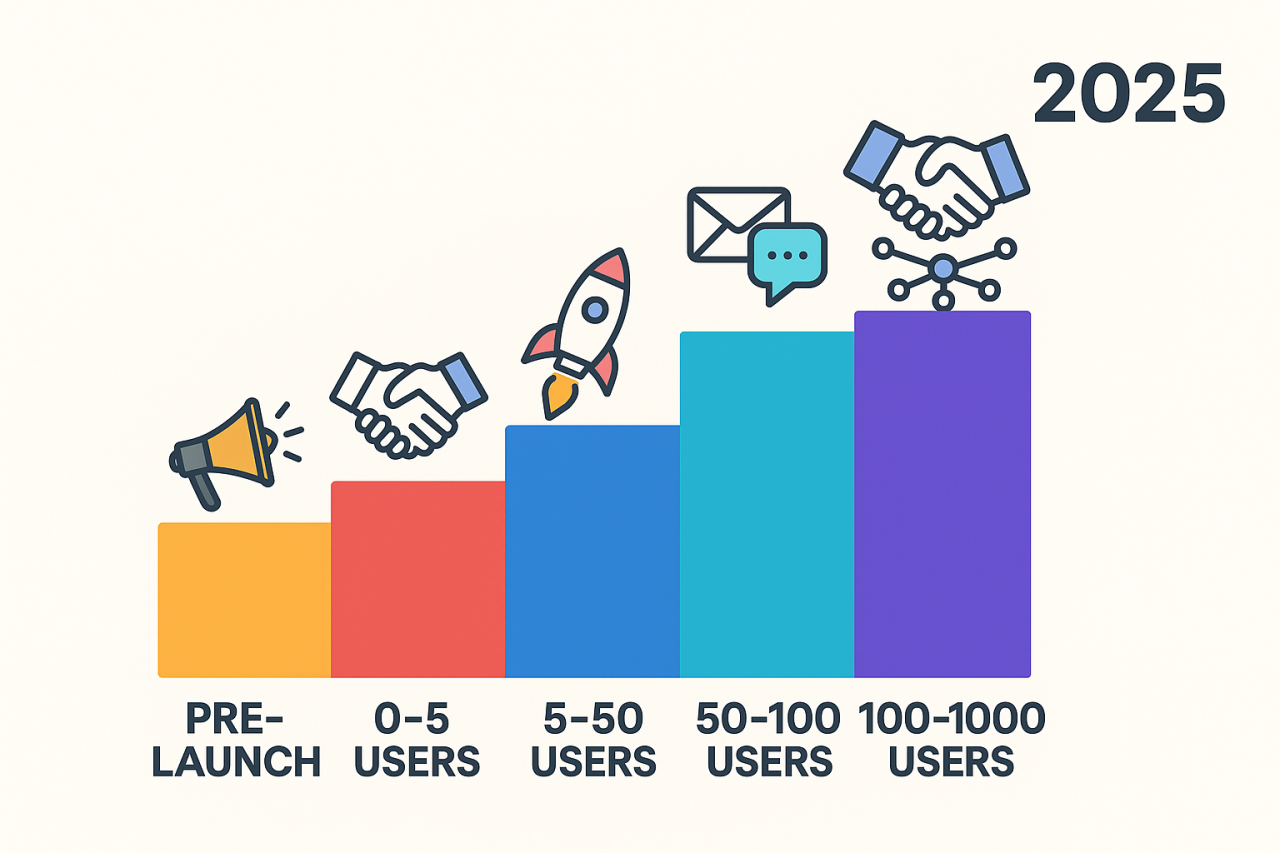Bing has evolved beyond being “just an alternative” to Google. In 2025, this search engine – long underestimated by many marketers – has become a strategic opportunity. Recent improvements in its algorithm, deep integration with Microsoft products, and a growing share of special audience segments mean that ignoring Bing is no longer wise. Smart SEO strategists are realizing that Bing can deliver high-quality traffic, especially for certain niches and enterprise audiences. As perceptions shift, understanding Bing’s strengths and differences is key to a well-rounded SEO plan in 2025.
May 15 2025 • 17 min read • 3296 words
Why Bing Deserves Your SEO Attention in 2025
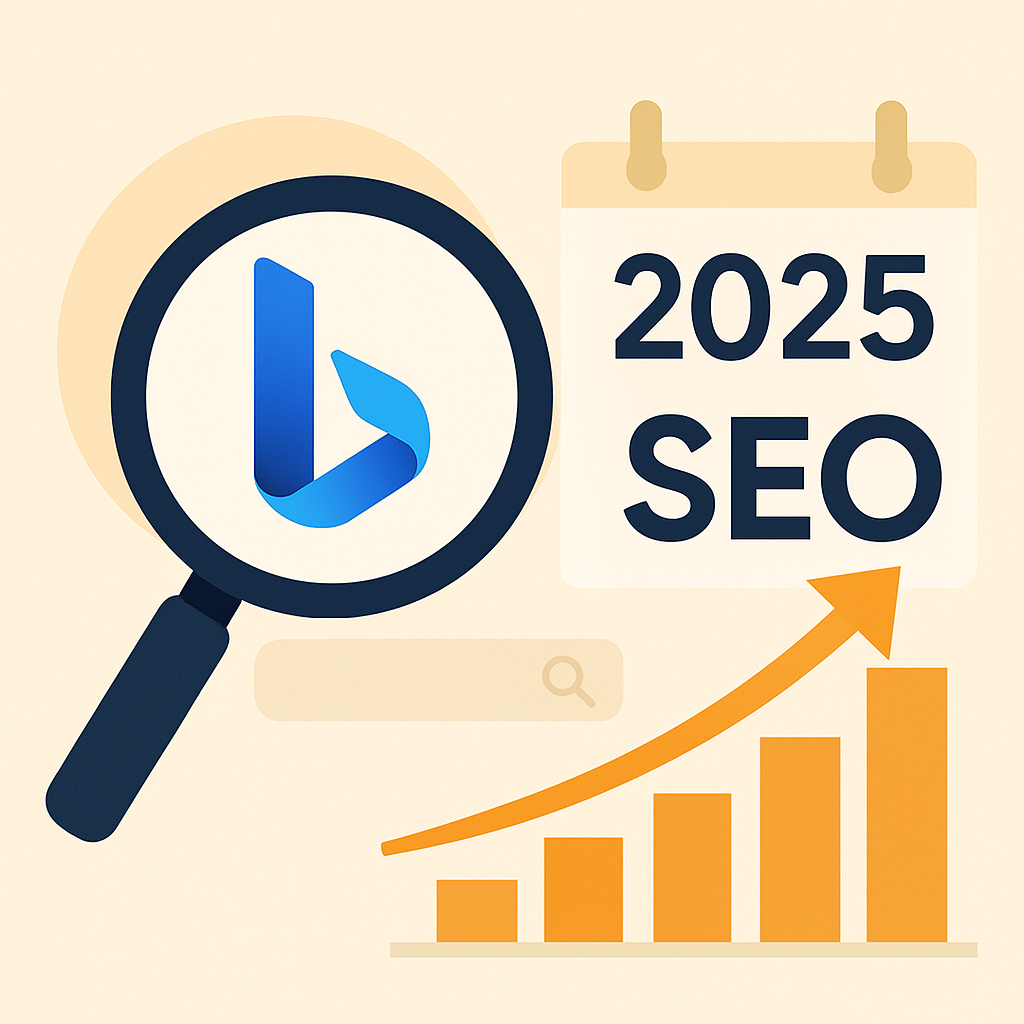
Bing Market Share and Traffic Stats (2025)
Though Google still dominates search, Bing’s numbers are substantial and worth noting. Globally, Bing handles roughly 3.9%–7.5% of all searches. That translates to over 12 billion searches per month (about 140+ billion per year). In the United States and in enterprise environments, Bing’s share is even higher – around 7–8% of searches. In concrete terms, while Google holds nearly 90% of global search market share, Bing’s slice is about 4% worldwide, with pockets of much higher usage among corporate and Windows-based users. Every month, millions of users rely on Bing to find information on the web, making it far from negligible. Ignoring these numbers means missing out on a sizable audience segment.
Even more importantly, Bing’s audience has unique characteristics that can benefit targeted sites. Many Windows and Office users default to Bing (via Edge or Windows Search), and sectors like B2B, finance, manufacturing, and government often rely on it. With this built-in user base – and powerful tools behind the scenes – Bing deserves attention alongside Google. The rest of this guide explores why Bing matters technically and strategically, and how optimizing for it can complement your SEO strategy in 2025.
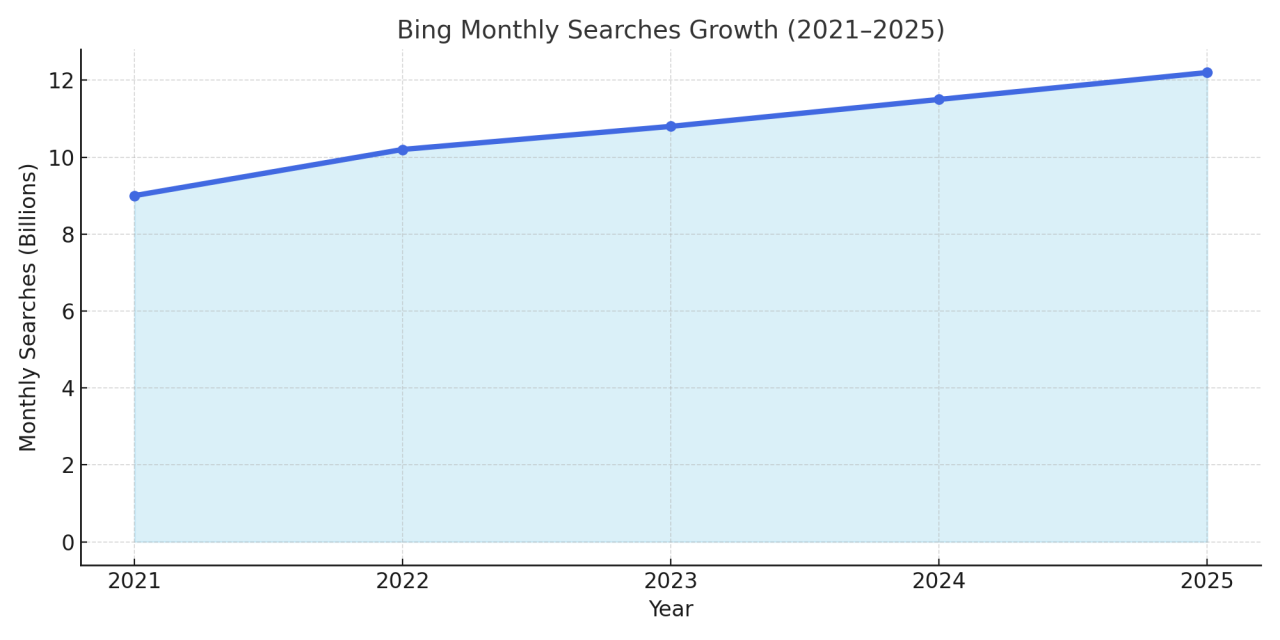
Technical Advantages for Developers
Bing provides a range of tools and features that make it attractive to developers and site owners. Three key technical advantages stand out.
IndexNow (Instant Indexing)
Bing pioneered the IndexNow protocol (with Yandex) for immediate indexing. Instead of waiting for Bing’s crawler to discover new or updated pages on its own schedule, you can use IndexNow to instantly notify Bing of URL changes. This means fresh content – new blog posts, product pages, news, etc. – can be indexed within minutes. Developers can use simple API calls or plugins to automatically send IndexNow pings whenever content changes. For fast-paced sites (e-commerce deals, breaking news, etc.), this ensures Bing’s index stays current. (Google has not adopted IndexNow, so this gives Bing an edge for speed.)
Structured Data & JSON-LD Support
Bing fully supports modern structured data formats, including JSON-LD and other schema markup. By adding structured data (like FAQPage, Product, Article, and other Schema.org types) via JSON-LD, developers help Bing understand and highlight the content. This can lead to enhanced search results (rich snippets with reviews, prices, event info, etc.) in Bing’s results pages. Unlike some older search engines, Bing’s crawler parses JavaScript and JSON-LD reliably. In practice, adding structured data is a low-effort way to boost visibility: for example, marking up a recipe or product can result in an attractive result with ratings in Bing. Google also rewards structured data, but Bing’s straightforward JSON-LD support makes it easy to implement for both.
Bing Webmaster Tools
Bing’s equivalent of Google Search Console is Bing Webmaster Tools (BWT). Many webmasters find BWT simpler and more intuitive, while still offering powerful insights. Key features include an easy interface for submitting sitemaps, checking crawl status, and using the “Submit URL” function to queue pages for re-indexing (powered by IndexNow). The SEO Reports and SEO Analyzer tools can automatically audit your site and highlight issues in markup or content. BWT also provides keyword research and ranking data, backlink analysis, and a sitemap validator. For developers, the BWT API allows automated management (useful for agencies or large enterprises). In sum, Bing Webmaster Tools covers all the essentials – from crawl diagnostics to performance reports – with fewer screens and clutter than Google Search Console. This means developers spend less time digging through menus and more time fixing issues. Overall, Bing’s technical features (fast indexing, rich data support, and streamlined tools) give developers every reason to build and optimize for it.
SEO Differences Between Bing and Google
Bing’s ranking algorithm has many similarities with Google’s – both value quality content, page speed, and user experience. However, there are notable differences that affect how you should optimize.
Google officially uses mobile-first indexing, meaning it predominantly crawls and indexes the mobile version of pages. In contrast, Bing continues to use a desktop-first, device-agnostic approach (because Windows OS). Bing’s engineers have said they maintain a single index optimized for both mobile and desktop. In practice, this means Bing usually looks at the desktop content when evaluating a page. Takeaway: A site should still be responsive (always a good practice) and mobile-friendly for Google’s sake, but ensuring your desktop content is fully optimized is crucial for Bing. For example, don’t hide important text or sections in a way that mobile Google sees it but Bing doesn’t. Always match content and tags between desktop and mobile versions.
Bing tends to prefer exact-match keywords and older SEO signals a bit more than Google does. In Bing’s algorithm, putting your main keyword phrase in the title tag, URL, and meta description can boost relevance. Bing also still recognizes the old meta keywords tag (though use this sparingly – don’t spam it). While Google largely ignores the meta keywords field, including a handful of well-chosen keyword variations there can give a tiny boost in Bing. In short, don’t obsessively stuff keywords, but include your target terms naturally in titles, headings, and early in body text. Write a clear meta description containing key phrases, because Bing may use that for ranking (and it helps click-through too).
Meanwhile, Google’s approach is much more semantic. Google uses its knowledge graph and natural language understanding to match user intent, synonyms, and related topics. Bing is more literal: it matches keywords closely. For example, if you target “enterprise HR software” and someone searches that exact phrase, Bing will favor pages that mention it verbatim in prominent places. Google might rank a page about “business human resource platforms” even if the exact term isn’t repeated, because it understands the meaning. Practical tip: Optimize for Bing by including exact phrases and common variations in your content and meta tags. For Google, also add semantic synonyms and context to cover related queries.
Expanding on the above, Google’s machine-learning algorithms try to understand context, while Bing’s current model is slightly more straightforward. This means Bing often rewards clarity and precise language. Use clear headings and simple sentence structures in Bing-oriented content. Meanwhile, Google rewards deeper content that covers a topic broadly and authoritatively, even if it uses different wording.
Google mainly uses meta descriptions to attract clicks, not for ranking, but Bing still gives them some weight for relevance. Write concise meta descriptions with your key phrase and a compelling call-to-action. Also ensure all images have alt text – Bing uses that text for context more than Google does. For example, an ecommerce site might see a small SEO lift on Bing by including exact product names and categories in image alt attributes.
While both engines can crawl JavaScript, Google is stronger in this area. Bing’s crawler may have more difficulty indexing heavy JS-driven content. If your site relies on JS frameworks, consider server-side rendering or pre-rendering critical content. This ensures Bing actually sees the text and links. As a tip, test important pages in Bing Webmaster’s SEO Analyzer (or use the live URL inspection) to confirm the content is indexed as expected.
Overall, think of Bing SEO as “traditional but still modern”. Continue with best practices (fast speed, good content), but maintain some older tactics like thorough meta tags and exact keyword usage. Cover both literal and semantic angles: if possible, have synonyms sprinkled in and clear keyword phrases directly in your HTML. This balanced approach satisfies both engines.
Backlinks in Bing
Backlinks remain important in both Bing and Google, but Bing’s emphasis is on natural growth and contextual relevance rather than sheer link volume.
Bing tends to devalue spammy or irrelevant links more aggressively. Rather than mass link-building, focus on earning links from authoritative, topical sites. For instance, if you run a B2B tech blog, getting a link from a well-known IT news site or industry association will carry more weight than dozens of low-quality directory links. A handful of links from respected sources can outperform hundreds of random backlinks in Bing’s eyes.
Bing’s algorithm looks at how well a linking page matches your content’s topic. Links placed naturally within relevant articles or blog posts count more. For example, a mention of your product in a niche review site (with a contextual anchor like “manufacturing analytics platform”) will be more valuable than a generic link on an unrelated page. When you guest-post or collaborate, choose sites in your field. This aligns with Bing’s focus on context.
Bing historically has given some extra trust to links from educational or government domains. If it’s relevant, consider ways to earn .edu or .gov links (like research partnerships, sponsorships, or community programs). These links may boost credibility more on Bing. (Google’s take on .edu/.gov is more neutral, so this is a unique plus for Bing SEO.). Avoid aggressive link schemes. Bing’s index may re-crawl and penalize overt manipulation. Instead, grow links organically: create link-worthy content (guides, infographics, case studies), and then promote it. Over time, high-quality backlinks will accumulate. Bing rewards genuine brand mentions and referral traffic.
In summary, build links as if you were writing for a human audience first, search engines second. Bing rewards that mindset. For example, a SaaS company that focused on partnerships and content marketing (earning 10 relevant industry blog links over a year) saw significant gains in Bing traffic. Emulate strategies like round-up posts, research reports, or resources that naturally attract industry links. This aligns with Bing’s backlink philosophy and improves rankings more sustainably than short-lived link spam.
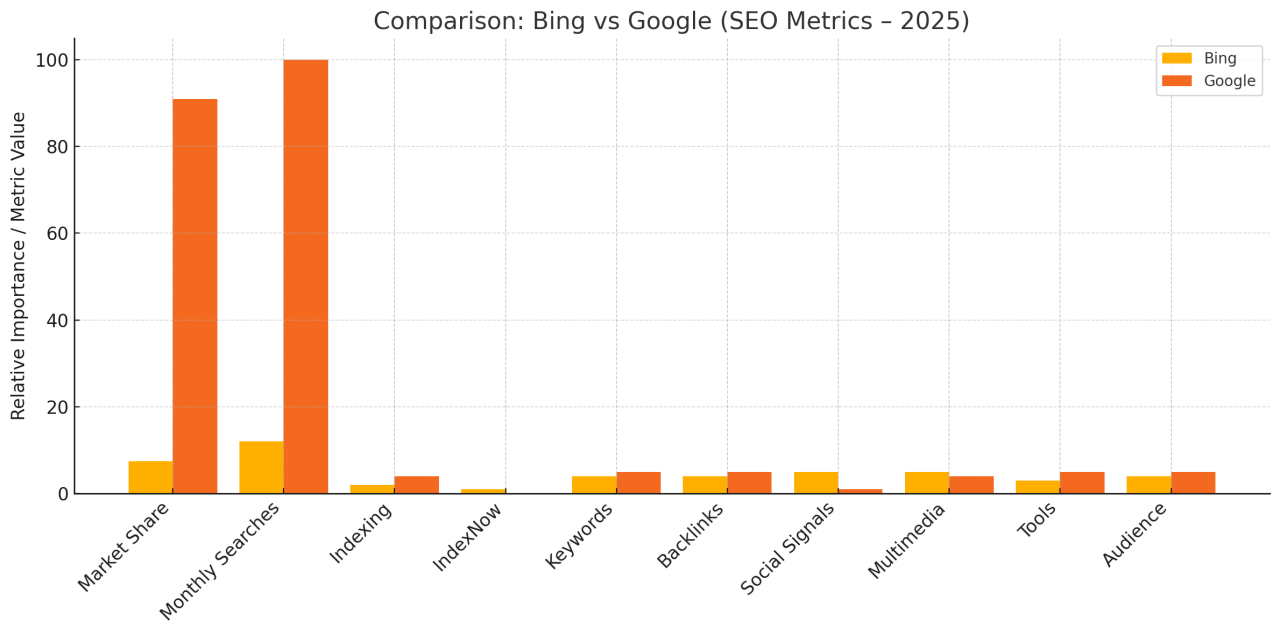
Social Signals and Bing
One of Bing’s standout differences is its integration of social signals. Bing has explicit ties to major social networks, and it does use social engagement as a ranking influence.
Bing accesses X’s (ex Twitter) real-time firehose API, which means trending tweets and recent content can be discovered instantly. If your content gets tweeted by influential accounts, Bing is likely to index and rank it quickly. For example, if a tech influencer tweets a link to your article, Bing may push that article to the front of search results sooner. To leverage this, encourage sharing on Twitter and engage with relevant hashtags or events.
Bing also recognizes signals from platforms like Facebook and LinkedIn. Shares, likes, and comments on these networks can amplify your brand’s visibility in Bing’s algorithm. In practice, while Bing can’t "see" every like (due to privacy), it does see public posts and profile authority. A strong LinkedIn presence (especially for B2B) can boost credibility. For instance, publishing an article on LinkedIn Pulse or encouraging employees to share content can indirectly boost Bing indexing and ranking.
Bing pays attention to how widely content is shared and engaged with. Content that has high share counts or discussion threads around it tends to be seen as valuable. That’s why adding easy social share buttons to your blog and making content easy to tweet or post can help. A practical tip: when you launch a new piece of content, coordinate a social blitz. Post it on your company Facebook page, have team members tweet about it, and share it on LinkedIn. The combined activity sends positive signals to Bing. Bing may also look at the authority of the social account sharing content. For instance, a tweet from a verified news outlet or a tech journalist carries more weight than from a new account. Building your own brand’s social authority (through follower count, engagement, consistent posting) can amplify the benefit.
Unlike Google (which mostly downplays social metrics in rankings), Bing acknowledges that active social engagement means your content is noteworthy. As a strategy, companies focusing on Bing should regularly update social profiles, share new or updated pages, and foster online community engagement. Over time, these activities not only improve brand awareness but also yield direct SEO advantages on Bing. For example, a small retailer saw its new product pages rank faster in Bing once they started tweeting daily deals and getting retweeted by local influencers.
Traffic Quality From Bing
It’s well-known that Google drives enormous traffic volume, but Bing’s traffic – though smaller in quantity – often leads to higher engagement and conversion.
Bing users tend to skew slightly older and more affluent. Many are professionals using Windows desktops or Office environments. These users often have clear intentions when searching (e.g., “buy enterprise software quote” or “book conference room venue”), which leads to deeper engagement. Sites often report that Bing referrals spend more time on site and visit more pages per session on average. One case study found that a B2B site’s average session duration from Bing was 20% longer than from Google search traffic.
Because Bing users often conduct targeted searches, they are less likely to bounce off after one click. For example, someone searching on Bing for a specialized service may have a specific need and be ready to explore. Many web analytics reports show lower bounce rates from Bing referrals compared to Google referrals, especially in niche markets like industrial equipment or financial services.
In paid search, it’s documented that Bing Ads (Microsoft Ads) often yield higher conversion rates at lower cost-per-click. The same tends to apply organically: if a user finds you on Bing, they may be further along the buying cycle. For example, an insurance website found that forms filled by Bing search visitors converted at a 30% higher rate than those from Google search. While results vary by industry, it’s common for B2B and enterprise-oriented sites to see stronger conversion metrics from Bing traffic.
A key example is the professional sector: when executives or managers search on Bing (often on their work computers), they’re likely researching products to buy for their company. If your site caters to this audience, optimizing for Bing can yield high-quality leads. For instance, a software vendor discovered that leads generated via Bing had a 15% higher lifetime value than leads from Google (since they tended to be decision-makers rather than casual browsers).
Bing’s traffic might be smaller in volume, but it can be more targeted and business-ready. For content publishers and marketers, this means you can expect higher average dwell time, more pages viewed, and stronger conversions from Bing. To capitalize on this, ensure your Bing-optimized pages have clear calls-to-action, simple navigation, and conversion tracking (so you can measure success). Recognize that a big jump in Bing visits might translate to an outsized jump in sales or leads, especially in professional niches.
When Bing Isn’t an Alternative—But the Better Choice
Industries like B2B tech, manufacturing, finance, healthcare, legal, and government often see a disproportionately high number of searches on Bing. Why? Many professionals and institutions default to Windows and Edge (which uses Bing). For example, government computers often have Bing set as default. A financial advisory firm targeting corporate clients might find that their audience is more likely to use Bing at work. In these niches, prioritizing Bing SEO can yield a competitive advantage, since fewer competitors optimize there.
If you advertise with pay-per-click, Bing Ads (Microsoft Ads) typically have lower competition and cheaper CPCs compared to Google Ads. That is also a signal for organic. A lower bidding environment often means organic keywords face less saturation. Focusing on Bing can be a cost-effective way to capture search visibility. In practice, marketers often report that long-tail or high-value keywords are much cheaper on Bing’s ad platform. By extension, optimizing for those queries on Bing organically can provide better ROI.
Nearly every Windows PC and laptop has Bing integrated. Windows Search (the desktop search box) and Microsoft’s Cortana assistant often default to Bing results. This means a vast number of users (especially in corporate and educational settings) passively use Bing throughout their day. For any business whose audience spends time on Windows 10/11, optimizing for Bing ensures you reach these default-search users. Additionally, Microsoft's ecosystem (Xbox, Outlook, Office sidebar search) surfaces Bing in various contexts. For example, Microsoft Rewards incentivizes Bing searches for points, making some users habitually use Bing for daily queries.
Certain local search categories see strong Bing usage. Bing Places for Business is a free local listings platform; having a robust Bing Places profile can make you appear in Bing’s local pack. If your customers search for services like “attorney in Phoenix” or “electrician near me” and many are on Bing (which is common in certain regions), then focusing on Bing Local SEO can drive leads.
If your business uses Microsoft products (Azure, Office 365, Dynamics, Teams, etc.), there are synergies with Bing. For example, SharePoint or Teams searches can surface Bing results. Advertising on Microsoft’s network also allows direct integration with Bing ads. From a branding perspective, being visible on Bing means aligning with the entire Microsoft ecosystem. For companies targeting corporate clients who invest in Microsoft, Bing often reaches decision-makers through company portals and on-the-job search habits.
Bing vs Google: SEO Metrics Comparison – 2025
| Metric | Bing | |
|---|---|---|
| Market share | ~4% globally (higher, ~7–8% in the U.S. and Windows environments) | ~90% globally, dominant share in nearly all markets |
| Indexing method | Desktop-first, single-index approach (no mobile-first policy) | Mobile-first indexing (mobile content prioritized) |
| Social signals | Integrated (uses Twitter API, Facebook, LinkedIn shares) | Minimal direct effect (publicly, Google says they do not use social metrics) |
| Keyword strategy | Exact-match focus, uses title/URL/meta keywords heavily | Semantic understanding (context, synonyms, latent topics) |
| Backlink philosophy | Natural, high-quality links in context (prefers .edu/.gov links) | Broad emphasis on link relevance and volume |
| Multilingual support | Full hreflang support (use subfolders, tags); rewards localization | Full hreflang support (also auto-detects mobile locales) |
| UX ranking signals | Page speed and user engagement (bounce/CTR) matter; less formal core vitals | Core Web Vitals, mobile usability, and overall UX are critical |
| Webmaster tools | Bing Webmaster Tools (simple UI, SEO Analyzer, IndexNow URL submit) | Google Search Console (robust data, schema testing, indexing tools) |
| Ad competition | Generally lower CPCs and fewer advertisers in many niches | Very high competition, especially for commercial queries |
| Typical audience | Older, professional/enterprise users (Windows/Edge default) | Broad, mobile-first consumer audience |
Bing is no longer just a backup plan for SEO — in 2025, it is a complementary and sometimes superior channel. By acknowledging Bing’s growing user base and understanding its unique traits, SEOs can unlock additional traffic, especially from engaged professional and regional audiences. From a developer’s standpoint, Bing’s technical tools (instant IndexNow pinging, JSON-LD schema support, user-friendly webmaster tools) make optimization straightforward. By tailoring your SEO strategy — balancing Google’s semantic leanings with Bing’s literal preferences, earning context-relevant backlinks, and harnessing social signals — you diversify risk and reach new segments.
In concrete terms, this means optimizing your site for both engines: keep it fast and mobile-friendly (to satisfy Google) while also emphasizing desktop content completeness (for Bing), precise keywords, and active social engagement. Nurture high-quality links and consider Bing’s local and multilingual capabilities. For certain industries — notably B2B, finance, manufacturing, and local services — Bing can even outperform Google in conversion efficiency. The bottom line: Treat Bing as a partner in your SEO strategy, not a sideline. With smart, measurable actions and by leveraging Bing’s advantages, you can capture a larger slice of the search market and drive traffic and leads that might otherwise slip through the cracks. In the era of diversified search, giving Bing due attention can make your SEO strategy more resilient and profitable than ever.
You might like

Its Time to Do It: Adapt Website SEO to Google’s AI-Driven Search
May 23 2025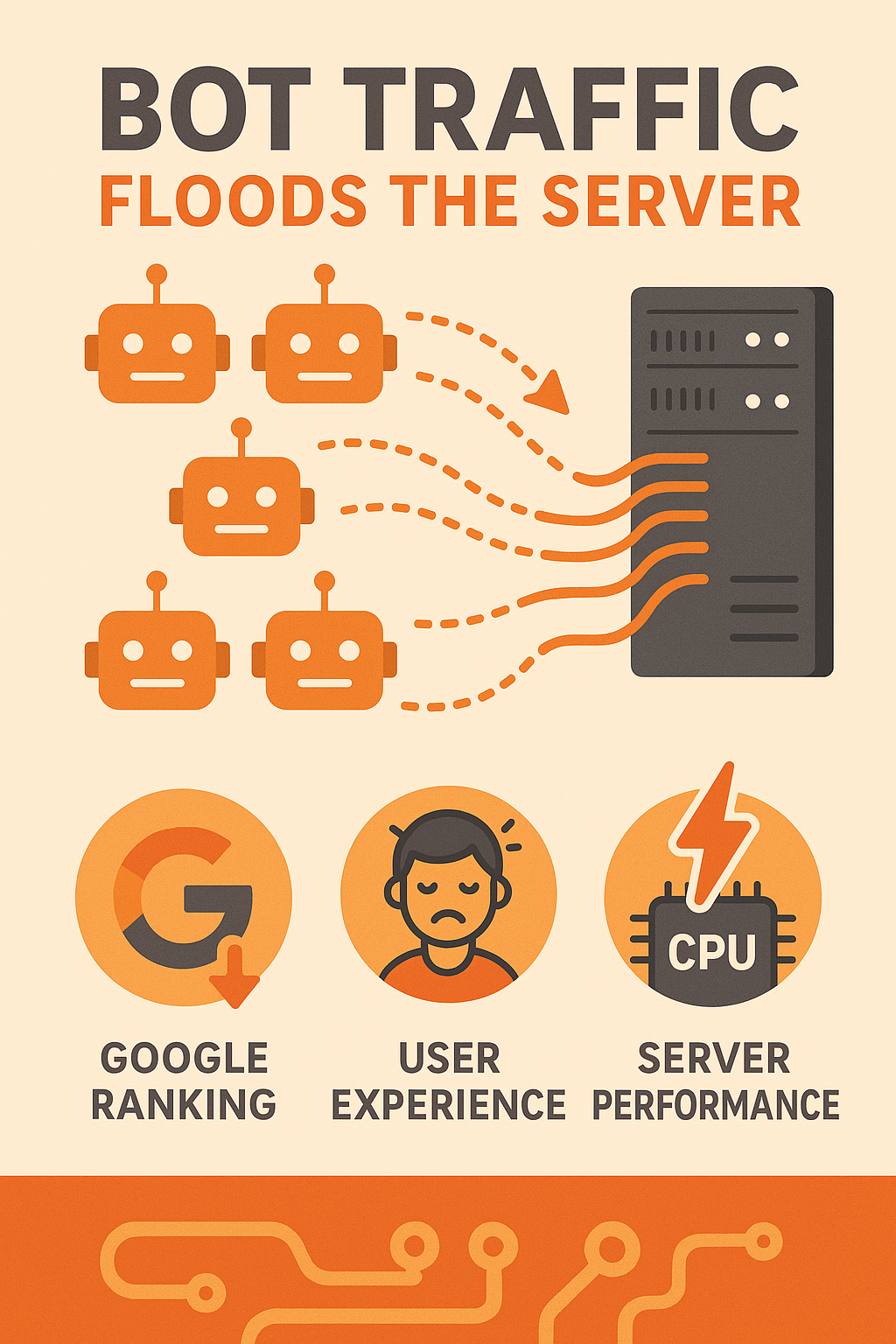
How Bot Traffic Nearly Destroyed My Website: Flood Crisis
May 29 2025
How to Create a Successful SaaS Product: From Idea to MVP and Beyond
May 02 2025
Users vs. Customers in SaaS: Understanding the Difference and Driving Conversions
May 08 2025